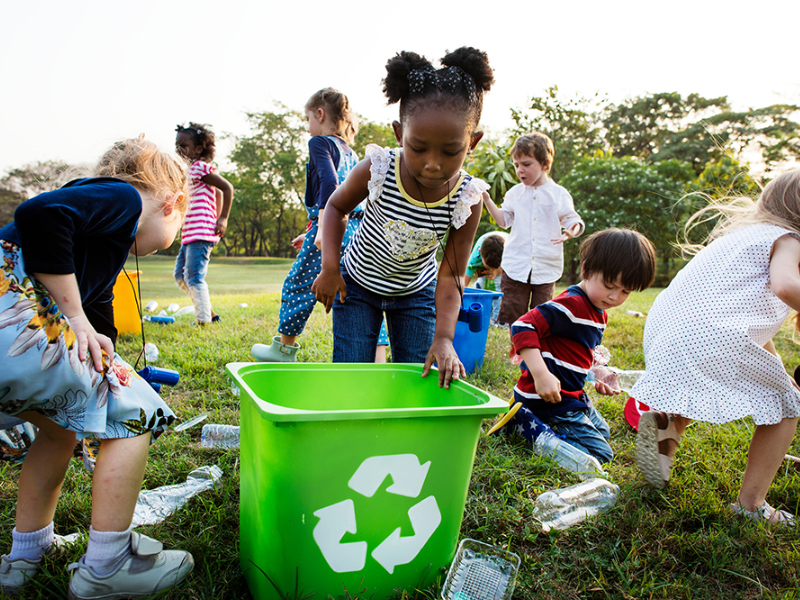On April 22, we are celebrating Earth Day. The theme this year is “Restore Our Earth.” After living through a pandemic for the last 14 months and adjusting the way our kids go to school, socialize with others and do things in public, one thing that remains unchanged is our connection with nature. While most Earth Day activities in the Washington, D.C. metropolitan area will be virtual again this year, we encourage children to focus on simple earth-friendly projects with their families at home.
What is meant by “restore”? How do we explain that concept to children? What specific tasks can children do to restore things?
Typically, the word “restore” brings to mind the concept of furniture restoration. Furniture restoration is a process to return a furniture item to its original beauty or functionality when it is damaged, broken or flawed in some way. The process of restoring the earth is similar. It is like saying that the earth is damaged or broken and we must do things to restore its natural beauty. For example, our bodies of waters are polluted with garbage. We can restore rivers to their natural state by doing cleanups. The example of restoring furniture helps us teach our children how to restore the earth through small, actionable steps.
Let’s talk about some dos and don’ts. The don’ts represent the behaviors that people usually exhibit. The dos are better eco-friendly alternatives.
1. Don’t send your child to school on a school bus until they understand what happens to our air when traditional diesel-powered buses operate in every city in every state throughout the nation.
Do teach your children the positive benefits of electric school buses and encourage them to write a letter to their school district asking that they use electric buses.
When gas-powered school buses and cars drive on our streets, they emit carbon dioxide. Collectively, all of that carbon dioxide is slowly damaging our earth by causing its temperature to rise (also known as climate change). A few school districts in the United States have started to replace their older buses with electric school buses. Locally, the Howard County Public School System began piloting electric buses. And Montgomery County recently signed the largest electric school bus deal in the U.S. with 326 electric buses replacing diesel ones within four years and eventual complete electrification of its fleet, which could be by 2035.
Children of any age can learn from those examples and write letters to their local school district, explaining that electricity-powered school buses are better for the environment and that they help produce cleaner air. By writing a passionate letter from their youthful point of view, children can make a difference in their local community.
2. Don’t buy new clothes or toys.
Do visit local thrift stores and explore the thrill of the scavenger hunt by purchasing used clothes, toys, games and room decorations!
Society conditions people to buy the latest trends in clothes, technology and children’s entertainment. Now is a great time to break out of that financially draining mindset by shopping locally at thrift stores and consignment stores. The prices are significantly less than buying new and the selection is undeniably diverse. By teaching children to buy used instead of new, you’re teaching them the value of a dollar while helping them restore the earth and its natural resources. Buying used means there is less of a need to generate dangerous fossil fuel gases typical in the manufacture of goods.
3. Don’t let cashiers give you plastic bags for your purchases.
Do bring your own reusable bags or better yet, search for empty boxes while at the store!
Plastic bags have been causing havoc to aquatic life for years. There are terrifying videos showing dramatic things that happen to animals when their body parts get caught with plastic. Most importantly, plastic takes 1,000 years to decompose, making this convenient item a threat to our landfills and earth. A far better alternative is to purchase or make your own cloth-based reusable bags. Children can reuse their old shirts and pants by cutting out the fabric, making coarse “ties” along the seams and creating their own stylish kid-inspired reusable bags. This is an easy art project that helps children feel proud that such a small action can make a big impact in restoring the earth!
4. Don’t encourage too much eating of red meat at restaurants or at home.
Do encourage non-meat alternatives including chicken, fish and locally grown vegetables, fruits and grains.
One of the biggest problems facing our earth today is that there are too many greenhouse gases polluting our clean air. Raising cows for beef uses up a lot of land and water, causing valuable natural resources to be tied into consumable beef production. One small and effective way to reduce those gases and restore our earth to clean air is not eating red meat in the first place. Red meat is a culinary preference; it is also filled with saturated fat that can cause health problems.
Children can learn by example to have a fulfilling meal without red meat. They may enjoy the grocery shopping experience of picking out their favorite healthy foods. Children can also visit local farms and farmer’s markets and understand that the less distance their food travels to them, the more they are doing to save the planet.
By taking small steps in their homes and locally within their communities, children can celebrate Earth Day not just for one day, but for a lifetime. Mother Earth needs our help to be fully restored. It takes the actions of many to produce a significant impact. What better way than through the power of our children? For more information on this year’s Earth Day, visit earthday.org/earth-day-2021.

